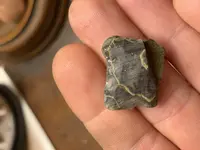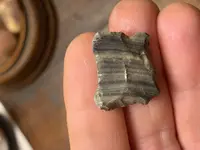Well, I have the advantage of knowing where this was found and some regional knowledge. Knowing the site is sensitive, let's just say "Central Virginia". This is very helpful because chert type rock is rare in that area, so it limits the possibilities. It does not match up with any of the known chert, chalcedony, or jasper sources in Central Virginia. It is a good match for some of the "mountain flints" that occasionally turn up in the area, such as this one which is probably the closest:
https://www.dhr.virginia.gov/lithics/augusta-and-rockingham-county-cherts/
It does appear to be the base of a lanceolote form with an auriculate base which in that region limits us to one of the paleo forms or Guilford. It is thin, well made, of "exotic" material for the site and shows a lame flute or at least aggressive basal thinning, at least on one side. That points to paleo, or more likely late/transitional paleo. McCoy and McCoy in their work along the Nottoway River do a good job of showing how Clovis changed over time from true fluting to more shallow fluting, or only fluting on one side, then to basal thinning, then to just a small, thin, well made lanceolate (like Midland). They used the regional name "Carson Lanceolate" for these transitional forms, which then further morphed into Hardaway side notched and Palmer corner notched. They peg Carson at 12,200-11900 BP (various "Clovis" forms they have as 13,100-12,200 BP). At the Richmond Site and Point-of-rocks Site in Chesterfield County, these transitional forms are called "Appomatox River".





